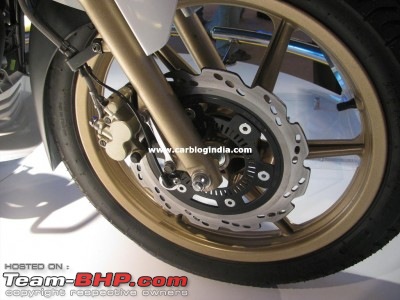|
KRP introduces a low-cost Anti-Lock Braking System imported from China Powerful front discs on powerful bikes are always a tricky affair to handle. While proficient riders modulate the hydraulic pressure effectively to handle emergencies, without locking the brakes, the case is not the same with their inexperienced counterparts. Squeezing the front brake lever is usually a common reaction by the not-so-honed rider in case of a predicament. The brake pads cling on to the discs, full force, locking the system, the front tyre slides, loses grip, the rider loses control, lands into a mess, and usually doesn’t come out of it without an injury.
Anti-lock-braking systems prevent the brakes from locking up, providing the rider more control in case of an emergency. The system allows the wheel to turn even when the brakes are slammed completely, lending the bike manoeuvrability even in panic situations. However, being very expensive and complicated, it’s not a viable option to install a proper ABS on bikes. Especially in a market like India where the economies of cost are the primary drivers for sales and even disc brakes are considered a luxury, it’s a very far fetched dream to think of installing such a system for the sake of biker safety.
So when we were offered a small one-piece kit, with ‘Motorcycle Hydraulic Anti-Lock Brake System’ neatly written over it for testing, we were more than amazed. The surprisingly small unit from Zhaoxiang Automobile & Motorcyclefittings Company of China costing a mere Rs 660 appeared nothing less than a miracle to us. Excited about the promise that the product held, we wasted no time and went straight ahead to test it on an Indian bike. We fitted it on a Hero Honda Karizma to find out the difference in brake feel, braking distance and time that the unit offered.
The gadget is quite simple in its operation and prevents the wheel from locking up by modulating the oil pressure on the calipers when the front brake lever is squeezed. Beyond a certain pressure point, it releases the pressure on the calipers, reducing the pads’ grip on the disc in turn, and thus allowing the wheel to turn. What remained to be seen, however, was how effective the system was in real life situations.
Fitting the system on a bike is no big task: you just have to remove the brake hose from the caliper unit and connect it to the ABS unit, while joining the other end of the system to the caliper unit. The unit that we got for test, however, was compatible only with ‘Nissin’ brakes. The oil seal for the fitment started dripping the moment we fit it, and had to be replaced to make sure that the oil didn’t leak. Even an additional washer was required, which was not provided with the unit.
Off we went, slamming only the front brakes for a number of runs, both, with and without the system. The unit worked wonderfully well for its size, mechanism and price. Okay, the brakes did lock up with the lever squeezed in the fist, but it surely prolonged the locking up state to a fairly distant point, as compared to what we could achieve on runs without the system installed. The effective braking time and distance too reduced, and that was a really pleasant surprise. The system does work, no doubt. In its own, limited way, if not like a full-fledged, electronically controlled ABS with all the techno-gimmickry of the world and an obscene sticker price, this little gadget makes a lot of sense. Bottom line, the inexpensive, compact unit, does justify being called an Anti-Lock Braking System and does prevent the wheels from locking up, up to a fairly reasonable extent
Source-Bike India/xBhp
Last edited by akshay4587 : 16th December 2008 at 08:56.
| 






 .
.